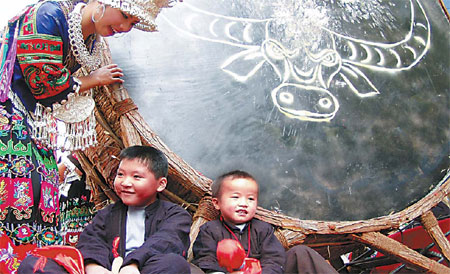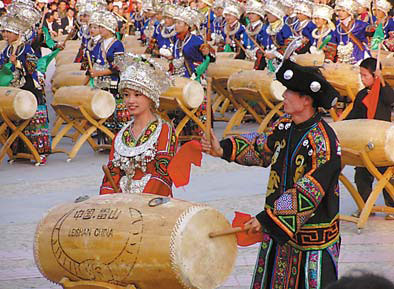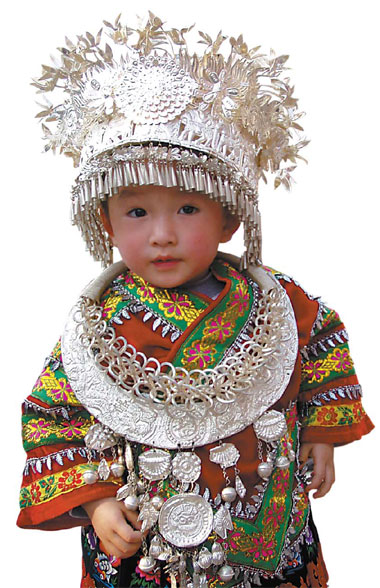Song remains the same
 |
| Two boys take a rest after beating the drum. |
The Leishan County Miao people in Southwest China's Guizhou Province are celebrating their New Year festival from this Saturday, until next Thursday.
The Chixin or Harvest Festival is the Miao people's most important annual event and is held to celebrate the harvest and pray for a prosperous new year. It is thought to have started in the Zhou Dynasty (1046-256 BC).
Today, most Miao people celebrate New Year in the first month of the lunar year, like the rest of China. But for 150,000 Miao in Leishan and part of Guangxi Zhuang Autonomous Region, the tradition of celebrating in the 10th month of the lunar year remains.
The festival usually lasts from five to 13 days. It is a time for the Miao to dress up in their best clothes, visit other villages, socialize and be entertained. A market is also set up to supply all the goods that are needed.
The best place to observe the Chixin Festival is Xijiang, a village in the Leigong hills, 40 km from the town of Leishan. Xijiang is said to be the biggest Miao village in the country and home to over 1,000 Miao households.
It is a traditional village. There are no fancy restaurants, bars or hotels, instead wooden houses built on stilts dot the hillside rice terraces.
The scenery is spectacular, with bails of hay in the fields complementing the lime green-colored rice terraces and settlement roofs made of bamboo. Ears of corns dangle from the balconies of the houses.
 |
| A drum-dance performance is often an important part of the New Year celebrations for Miao people in Lei-shan County. |
As the festival approaches, the Miao prepare traditional foods, slaughter pigs and goats, make sweet rice cakes and brew rice wine. The best food is reserved for worship and as gifts for neighbors and friends.
After a dinner and solemn rituals on the eve of the festival, it is time for the young Miao men and women to dress up in their traditional clothes and parade through villages singing and playing an instrument called the lusheng (a pipe music instrument made of bamboo and gourd).
The traditional costumes worn in Xijiang are considered to be the most beautiful among those worn by the various clans of the Miao ethnic group.
 |
| A Miao girl dressed up for the festival. |
According to Taiwan Province's Chen Ching-lin, an expert on costumes and accessories worn by minority groups in Southwest China, the Xijiang style is marked by elaborate patterns and bright, harmonious color arrangements.
Miao women from Xijiang, Chen adds, typically wear silver ornaments from top to toe. These can weigh up to 8-10 kg. To the Miao people, silver represents wealth and beauty.
(China Daily 11/16/2007 page18)














